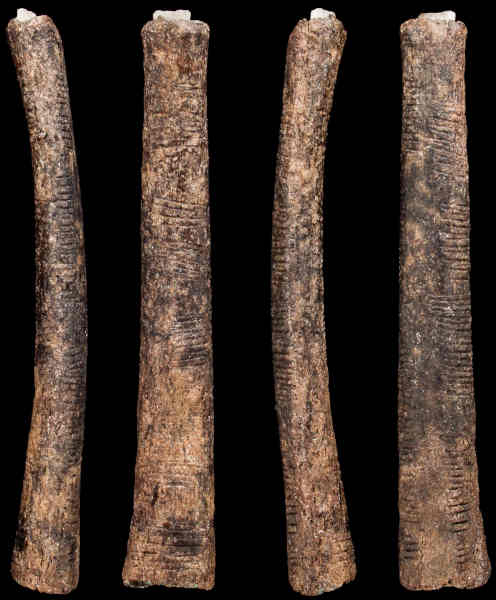Communications of the ACM
The African Enigma: Who Knows More?

Tally sticks and notched bones are among the oldest digital data carriers. Notched bones survive for thousands of years. Wooden tally sticks are less durable, but can be split into two parts (for example, one copy each for the creditor and the debtor) and are therefore largely counterfeit-proof.
One of the earliest examples of digital storage media is the Ishango bone, which is 20,000 years old and 10 cm long (see Fig. 1). It was found at Ishango (Congo) in 1950 and is now located in the Royal Belgian Institute of Natural Sciences in Brussels.
Finger counting is also digital and has been used since time immemorial. The (digital) abacus is regarded as the oldest calculating device. Contrary to popular belief, numerical processing was originally not analog, but digital. Even if the notches on the Ishango bone do not show any numbers, the representation is digital. Thus, digitization began in ancient times.

Fig. 1: Ishango bone.
For about 70 years, the meaning of the markings on this bone found in the Congo have been puzzled over.
Credit: Royal Belgian Institute of Natural Sciences, Brussels.
Unsolved puzzle
To this day, the scholars are arguing about the meaning of the find. The bone, equipped with quartz on one side, probably served as a tool. It apparently has 168 parallel notches (on three sides). The lines, however, sometimes have very different lengths, so that it is unclear whether this number really applies. This would be an important prerequisite for a meaningful interpretation. The fact that the long and the short strokes count equally is not very credible. Strangely enough, no bundling in groups of 5 or 10 is detectable. Due to the base 5 system and the decimal system (5 and 10 fingers, respectively), such a number representation would be obvious.
Different hypotheses (such as primes, duodecimal system, sexagesimal system, lunar calendar; see "Have you heard of Ishango?" Association pour la diffusion de l'information archéologique / Royal Belgian Institute of Natural Sciences, Brussels) are in circulation, but none is convincing because, as mentioned, the counting method of the notches is questionable, and the number representation is immature (no recognizable bundling). It seems unlikely there is any advanced mathematics behind this. There is a risk that the bone will be overinterpreted. Perhaps the lines fulfilled some statistical purpose, for example, in society, economics, religion, fertility, or hunting, or it may have served as a piece of jewelry. Maybe other finds could provide more information.
References
Have you heard of Ishango? Association pour la diffusion de l'information archéologique/Royal Belgian Institute of Natural Sciences, Brussels, undated, 21 pages
https://www.naturalsciences.be/en/museum/exhibitions-view/19/50/393 (in English)
https://www.naturalsciences.be/sites/default/files/Discover%20Ishango.pdf (in English)
https://www.naturalsciences.be/fr/museum/exhibitions-view/19/50/393 (in French)
https://www.naturalsciences.be/sites/default/files/D%C3%A9couvrez%20Ishango.pdf (in French)
https://www.naturalsciences.be/de/museum/exhibitions-view/19/50/393 (in German)
https://de.wikipedia.org/wiki/Ishango-Knochen
https://en.wikipedia.org/wiki/Ishango_bone
https://es.wikipedia.org/wiki/Hueso_de_Ishango
https://fr.wikipedia.org/wiki/Os_d%27Ishango
Herbert Bruderer is a retired lecturer in didactics of computer science at ETH Zürich. More recently, he has been an historian of technology. [email protected], herbert.bruderer@bluewin.
No entries found